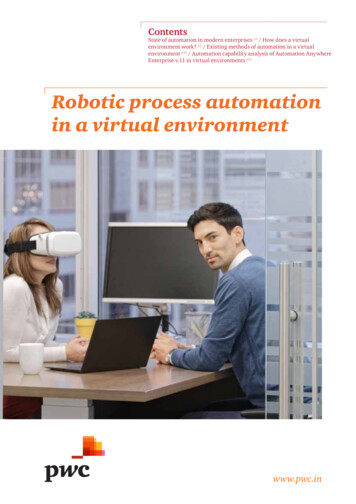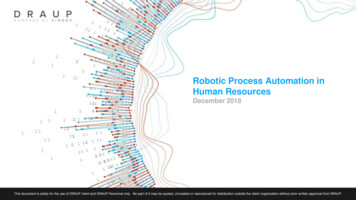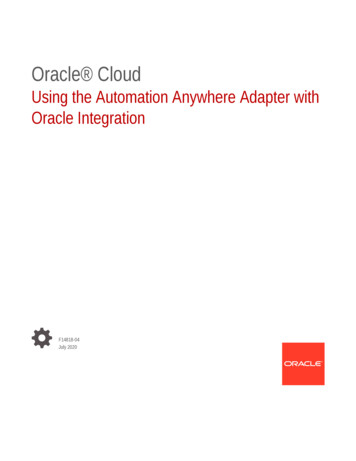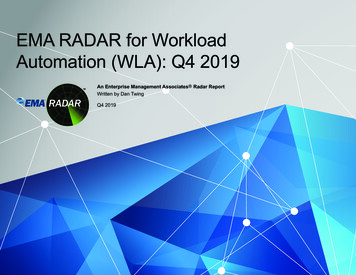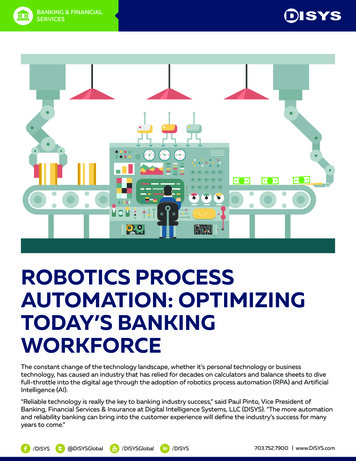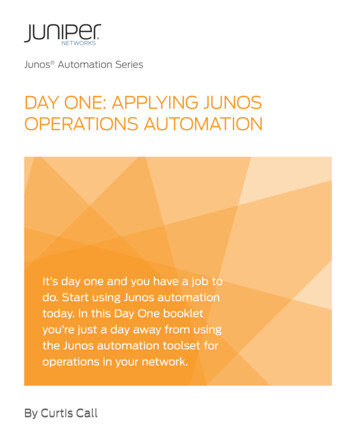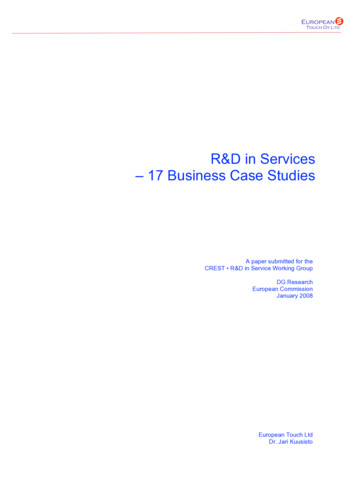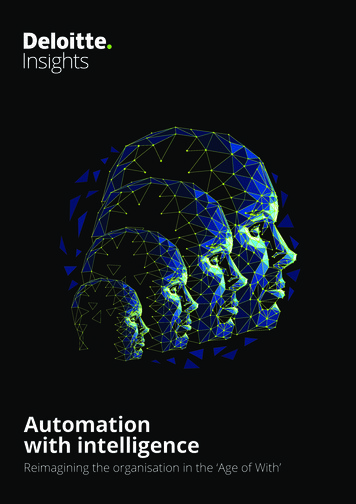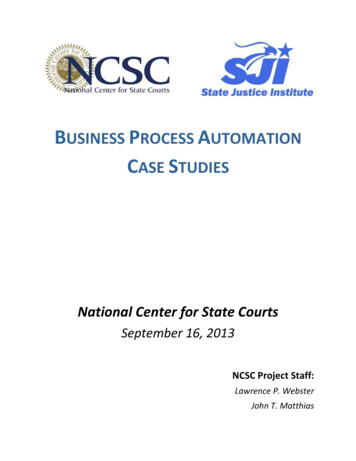
Transcription
BUSINESS PROCESS AUTOMATIONCASE STUDIESNational Center for State CourtsSeptember 16, 2013NCSC Project Staff:Lawrence P. WebsterJohn T. Matthias
2013National Center for State CourtsThis document was prepared under State Justice Institute (SJI) Grant SJI-11-P-085. Thepoints of view and opinions expressed in this document are those of the authors, and donot necessarily represent the policy and positions of the State Justice Institute. TheNational Center for State Courts grants the State Justice Institute a royalty-free, nonexclusive license to produce, reproduce, publish, distribute or otherwise use, and toauthorize others to use, all or any part of these documents for any governmental orpublic purpose.ii
TABLE OF CONTENTSExecutive Summary . 1Introduction . 3Part i: Learning from the Private Sector . 5History & Background of Private Sector Tools and Techniques . 5Human Productivity and Management Innovation . 5Operations Research and Operations Management . 5Capability Maturity Model . 6Applying Private Sector Theory to Courts . 8Organization and Structure . 9Management Control. 11Technology and the Courts . 12Case Management Systems . 12Reduction of Operational Costs. 13Business Process Automation . 14Part II: Case Studies . 19Phoenix Municipal Court . 19Overview . 19Background . 19Unique Characteristics . 20Exemplary Techniques and Best Practices . 25Remaining Issues . 27Key Players . 27Michigan Court of Appeals. 28Overview . 28Background . 28Unique Characteristics . 30Exemplary Techniques and Best Practices . 31Remaining Issues . 35Key Players . 35Judiciary of Puerto Rico . 36iii
Overview . 36Background . 36Unique Characteristics . 37Exemplary Techniques and Best Practices . 41Remaining Issues . 45Key Players . 45Part III: Exemplary Techniques and Best Practices. 46Organizational Structure . 46Business Analysts . 46IT Staffing . 47Operations Management Considerations . 47Operational Focus. 47Business Process Discipline . 48Quality Management . 48Performance Metrics . 49Case Management System Characteristics . 50Process Model . 50Case Properties . 52Business Rules . 52Case State Queues . 52Case State Sensitive CMS . 53Business Process Automation Support . 54System Development Methods . 55Top-Down and Bottom-Up . 56Start with the Work of Judges . 56Case Management System Standards . 57Business Process Automation Tools . 58Integration Issues . 59Conclusions . 60Glossary . 62Bibliography . 66iv
Business Process Automation Case StudiesSeptember 2013EXECUTIVE SUMMARYThe National Center for State Courts (NCSC) is pleased to present Business ProcessAutomation Case Studies. This document is part of the NCSC’s initiative to develop thenext generation of standards for court technology. The NCSC believes that futuresystems will focus on the automation of court business processes, applyingmethodologies and tools that have proven successful in the private sector. These casestudies highlight courts that have taken steps in this direction, having utilized improvedbusiness process discipline and methods, or business process automation tools.In Part I, this document examines private sector tools and techniques, followed by adiscussion of their relevance to the public sector and to the judicial branch. It thenexplores the evolution of technology to support the work of the courts.In Part II, this paper presents three case studies, including the Phoenix Municipal Court,the Michigan Court of Appeals, and the Judicial Branch of Puerto Rico.The Phoenix Municipal Court was selected because of the way that its internallydeveloped case management system has evolved to fit local business practices,significantly reducing staffing needs.The Michigan Court of Appeals was chosen because of its high level of business processdiscipline and the implementation of these principles in its case management system.The Judiciary of Puerto Rico is included because of its use of business processautomation tools to create SUMAC, its new case management system. The Puerto Ricocourts focused on the automation of the work of judges, in addition to clerical staff, andused a number of other innovative techniques.It is important to note that the case studies focus on the most impressive features ofthese three courts that are relevant to business process automation. While there aremany more good things happening in the three sites than are described in the casestudies, they are not included because they are not as directly related to the specificfocus of this document.In Part III, this document synthesizes the techniques and practices from which othercourts and private-sector software providers can learn about the future of technology incourts.Exemplary techniques and best practices extracted from the case studies have beenorganized into four categories: organizational structure, operations managementconsiderations, case management system characteristics, and system developmentmethods.In the area of organizational structure, the need for competent business analysts andinformation technology staff (whether internal or contractual) was emphasized.Under operations management considerations, a strong management focus on courtoperations was seen in each of the exemplary courts, including a desire to strengthenbusiness process discipline within the court. Private sector quality methodologies alsoNational Center for State CourtsPage 1
Business Process Automation Case StudiesSeptember 2013show the need to manage quality and control variation in each individual businessprocess. Developing and using performance metrics to manage quality also is a bestpractice.In the area of case management system characteristics, a number of exemplarypractices were defined: building process models for each case type, defining caseproperties and business rules needed for operational improvements, case state queuesthat can be managed by the CMS, and business process automation support.The final category is system development methods. Successful courts use acombination of top-down and bottom-up perspectives in defining the scope ofautomation projects. Future systems also will be more concerned with automating thework of judges. The need for improved case management system standards also wasemphasized. Business process automation tools should be considered by courts that areserious about improving court operations. Finally, integration with systems in otherjustice and justice-related organizations also is important.The private sector can teach courts many techniques that can produce operationalimprovements, though the application of those methods presents many challenges.Certainly the need for efficiency must be kept in proper perspective, but very inefficientcourts struggle to meet their higher goals of administering justice fairly. Bettermanagement and improved technology offer tremendous promise for dealing withthese issues.The NCSC believes that the next generation of court technology standards must focus onbusiness processes, which involves management, measurement, automation, andimprovement.National Center for State CourtsPage 2
Business Process Automation Case StudiesSeptember 2013INTRODUCTIONMost courts rely on case management systems to support their work. Traditional casemanagement systems are electronic filing cabinets: repositories of information,documents, and other content related to specific cases. Case management systemsalso automate some of the work of courts by producing documents, organizingcalendars, reporting outcomes to other parties and organizations, etc. Unfortunately,few courts take full advantage of this automation capability, choosing instead tomaintain parallel, manual processes. The net result of automation in many courts is toincrease in human effort in business processes, rather than to decrease it.One reason that courts are not able to take full advantage of technology tools is thatthey lack business process discipline. In many states, clerical functions reside in aseparate organization, often in a separate branch of government. In most states,business processes are shared with many other organizations (e.g., prosecution,indigent defense, child welfare, child support), but are managed within separate silos.In all states, a high degree of independence exists in the way that individual judges dotheir work. This makes that management of business processes difficult and theautomation of those processes almost impossible. Some states do not even attempt tomanage or document business processes, letting the people who do the work decidehow it will be done.Business process automation is used extensively in the private sector. Tools andtechniques have been available for more than twenty years, but now are much easier touse, much less expensive, and much more powerful. The focus of business processautomation is the individual business process. Subject matter experts and technicalspecialists work together to define the best way to perform a task. They produce aflowchart that describes the business process. The flowchart is fed into a system thatproduces the software tools needed to automate the process. Some manualprogramming still is required, but the framework has been created and the work can becompleted in a matter of days and weeks, rather than months and years. Individualbusiness processes can be automated very quickly, but when there are dozens orhundreds of processes to be addressed, the complexity increases rapidly. Still,business process automation tools have the potential to replace traditional casemanagement systems and to greatly streamline work processes and staffing in courts.A number of states are thinking about moving in this direction.The purpose of this publication is to highlight and publicize efforts by innovative courtsto follow the latest operations management trends in the private sector. By doing so,we hope to motivate other courts to take advantage of these powerful tools toNational Center for State CourtsPage 3
Business Process Automation Case StudiesSeptember 2013transform their business operations and to support a broader initiative to define thenext generation of court technology standards, based on business process automation.National Center for State CourtsPage 4
Business Process Automation Case StudiesSeptember 2013PART I: LEARNING FROM THE PRIVATE SECTORHistory & Background of Private Sector Tools and TechniquesIt is not a simple thing to compare judicial branch practices with private sectorinnovations. Courts are modern organizations in one sense, and eighteenth-centuryinstitutions in another. Structure and management control issues make it difficult forcourts to realize many of the benefits of technology that have accrued to privateindustry. Still, there is value in examining how improvements in human productivity andmanagement have been and may be applied to the judicial branch.Human Productivity and Management InnovationThe eighteenth century development of the steam engine and other forms ofmechanization are considered to be the forerunners of the industrial revolution. Thesetechnologies helped to transform the world from systems of craft guilds and domesticproduction to today’s modern manufacturing environment. Technological innovation,such as the concept of the assembly line, interchangeable parts, the railroad and otherforms of transportation, electrical and computer power, and communications probablywould have had a smaller impact were it not for progress in organizational andmanagement theory. This scientific management revolution forever changed the waythat work is done and the way organizations are structured.Operations Research and Operations ManagementOperations management and operations research emerged from the scientificmanagement movement, though the titles are of somewhat recent origin. Operationsresearch is a branch of mathematics that overlaps operations management andindustrial engineering. It focuses on the application of advanced mathematical modelsto decision making. Operations research uses mathematical modeling, statisticalanalysis, simulation, queuing theory, mathematical optimization, and many otheranalytical techniques to find optimal or near-optimal solutions to complex problems. Itemphasizes human-technology interaction and seeks practical, rather than theoreticalapplication. It can be seen in almost all aspects of our lives – from the grocery store, toschools, to gaming, and to sports.Operations management is concerned with overseeing, designing, and controlling theprocess of the production of goods and services. It ensures that the transformation ofinputs into outputs is effective and efficient. It is tactical, rather than strategic. Itblends both art and applied science. People skills, creativity, rational analysis, andknowledge of technology are key ingredients to success.Some of the more notable products of the operations management movement includeTotal Quality Management (TQM), Six Sigma (another quality control approach), LeanManufacturing, Just in Time, ISO 9000, and Business Process Reengineering. Keytechniques in the service area include: ForecastingNational Center for State CourtsPage 5
Business Process Automation Case Studies September 2013Quality assurance and controlDecision analyticsService designProcess planning and designJob design and work measurementInventory controlOperational scheduling and controlOperational analysis and maintenanceProject managementProductivity and throughput are key concerns of operations management. While thereis much that the courts can learn from operations management in the area of workdesign and process performance management, the analytical tools of operationsmanagement may be the best untapped resource for judicial branch leaders. Caseflowmanagement, CourTools, Trial Court Performance Standards, and the High PerformanceCourt Framework, while excellent tools, pale in comparison to the rigorousmathematical modeling used in operations management. Of particular note are processsimulation, queuing theory, and Markov chains. These tools have the potential tosignificantly improve customer service, scheduling, business process performancemeasurement, and differentiated case management, but few courts have tried to usethese techniques.Capability Maturity Model1Another interesting development has been the capability maturity model (CMM).Originally created after a study of data collected from organizations that contract withthe U. S. Department of Defense, it became the foundation of the Software EngineeringInstitute at Carnegie Mellon University. “Maturity” refers to the degree of formality andoptimization of business processes from:1.2.3.4.5.Ad hoc, chaotic practicesRepeatable processesFormally defined stepsManaged results metricsActive optimizationThe capability maturity model was initially used to determine the capability of acompany to develop computer software, but it has been expanded and can be appliedto the work of almost any organization.A diagram of the CMM below depicts progression from one level to the next, as businessprocesses become more defined and as they are measured and improved based onmeasurement.1The concept of business process discipline used in this paper is derived primarily from the CapabilityMaturity Model, though it also includes control of variation in business processes, as described in manyquality management methodologies.National Center for State CourtsPage 6
Business Process Automation Case StudiesSeptember 2013Courts typically score at level two of the model, but some are clearly at levels one orthree. A score of one would be applicable in a court in which not effort is expended tocontrol variation in the way that work is performed — either at the clerical or judiciallevels – where individual judges and clerks decide how they are going to do their work.A score of two indicates that there are generally accepted ways of doing business,perhaps with some documentation, while level three includes courts where there isformal documentation showing how to perform each process.Very few court organizations can claim to have the business process discipline definedat levels four and five because they lack the data required to measure individual processperformance – at even a moderately detailed level – and to optimize processes basedon that data. Analysis in most courts is generally confined to high-level outcomemeasures, such as CourTools, that do not reach the necessary level of specificity ofindividual business processes.2 Courts must acquire knowledge and skills in these areas,not to mention higher quality data and better process models, to improve businessprocess discipline.Process maturity takes years of focused effort to achieve, and courts will go throughphases, starting with improvement of a few processes, and gradually developing more2According to Tom Clarke, both the Washington and California state courts carried out extensive andserious process simulation pilot projects in the 1980's, using rigorous techniques like process simulation,queuing theory, and Markov chains. Formal models were created and exercised using real court data.Presentations were made at professional simulation conferences. However, projects in both states wereultimately abandoned because the benefits of the models didn't justify the cost. They were veryexpensive to create and maintain, court data was of low quality, and the business insights wereunderwhelming.National Center for State CourtsPage 7
Business Process Automation Case StudiesSeptember 2013sophisticated models, and then further refining the processes. The goals are to attainthe ability to create enterprise process models for the local court environment, tomeasure process results, to manage business processes, and to use teams tocontinuously improve their processes, as envisioned by the High Performance CourtFramework.3Courts certainly have benefited from many modern management ideas: staffspecialization and division of labor,4 defined job descriptions, business processdocumentation, and training, but many other innovations have not been successfullyimplemented. It is certain the courts could benefit from more advanced tools andtechniques. Here are some obvious areas: Work process design based on mathematical modelsAnalytics in measuring and optimizing the performance of specific businessprocessesSimulation tools and queuing theory for optimization of customer service andscheduling functionsDivision of labor and specialization in judicial processesRecommendations for application of these approaches are discussed below in SectionVIII: Exemplary Techniques and Practices.Applying Private Sector Theory to CourtsAn issue that is raised repeatedly when court leaders attempt to apply private sectorapproaches in the judicial branch is that “courts are different.” This is certainly true,and it is worth exploring how courts are different and how the differences andsimilarities apply in trying to improve operations.Courts as organizations are constitutional institutions, created at the founding of ourcountry and of our states. Inherent in their establishment is the requirement that theybe funded and supported in the execution of their duties. They resolve controversies;protect society; punish those who commit crimes; establish and modify the legal statusof individuals; defend the rights of citizens against abuse by the government, privateorganizations, and individuals; and ensure that the work of government is accomplished.There is no question that they are an important part of our democracy and nation.On the other hand, private companies produce goods and services (and jobs) that are ofvalue to people and organizations. They are authorized and regulated – but usually arenot funded – by government. They collect taxes from their customers (and employees),and a part of their profits usually are returned to the government as compensation for3The High Performance Court Framework is used to integrate performance improvement into a court’songoing operations. The steps include: focusing on key administrative principles that clarify highperformance, understanding how a court’s managerial culture can promote common goals and collegialcooperation, developing the capacity to measure performance, and learning to use the results forprocedural refinements and communication with a variety of stakeholders. Taken together the stepsform a functional system that courts can follow in enhancing the quality of the administration of justice.4Even organizational specialization, i.e., treatment courts.National Center for State CourtsPage 8
Business Process Automation Case StudiesSeptember 2013public services that they consume. The private sector also is an important part of oureconomy and our society.Courts receive a budget allocation (and sometimes fees from customers) to supportoperations. Some courts return more in revenue to their funding bodies than theyconsume in operational costs. Court leaders must justify budget requests and complywith financial management rules, participate in audits, and provide other proof thatthey have appropriately expended public funds allocated to them. Often tensions existbetween court leaders and funding bodies over the level of funding needed toadequately run the court system. Progressive court leaders assume that they have theresponsibility to apply sound management principles in operating the courts asefficiently as possible, without sacrificing the more important purposes of courts – toadminister justice fairly and impartially, to treat people with respect and dignity, and touphold the law.Private sector organizations are driven by the need to sell their goods and services. Ifthe cost of doing business exceeds revenue received for very long, the business will notsurvive. The private sector must be as efficient as possible, but it also is constrained byhigher goals — quality, compliance with legal requirements, and maintaining goodrelationships with their customers. Cutting corners in quality or customer service mayincrease profits in the short term, but it will lose customers in the long term.Private organizations compete for customers and contracts. They must remaincompetitive with other companies in terms of cost and quality. Courts have no suchincentive. Perhaps this is one reason why the private sector has made so much progressover the last 250 years – it has truly been the survival of the fittest. This is not to saythat courts are not doing their best to be effective and efficient, only that themotivation of the private sector is much more substantial.5The following subsections explore particular topic areas that describe fundamentaldifferences between courts and the private sector, with regard to organization,structure, and management control.Organization and StructureCourts operate at a disadvantage to private industry in many ways. One importantdifference is organization. Private companies can organize and reorganize themselvesto suit the changing competitive environment. Court organization and structu
Business Process Automation Case Studies September 2013 National Center for State Courts Page 2 show the need to manage quality and control variation in each individual business process. Developing and using perfo

